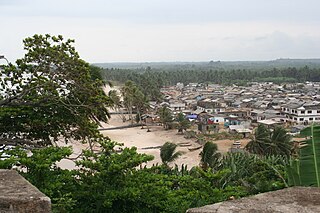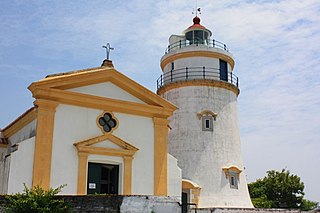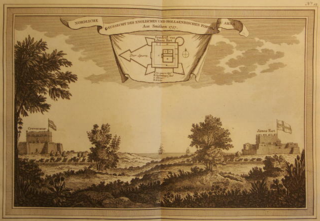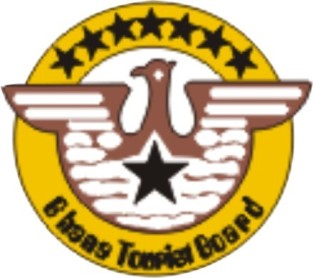
Cape Coast is a city, fishing port, and the capital of Cape Coast Metropolitan District and Central Region of Ghana. It is one of the country's most historic cities, a World Heritage Site, home to the Cape Coast Castle, with the Gulf of Guinea situated to its south. According to the 2010 census, Cape Coast had a settlement population of 169,894 people. The language of the people of Cape Coast is Fante.

Elmina Castle was erected by the Portuguese in 1482 as Castelo de São Jorge da Mina, also known as Castelo da Mina or simply Mina, in present-day Elmina, Ghana, formerly the Gold Coast. It was the first trading post built on the Gulf of Guinea, and the oldest European building in existence south of the Sahara.

Cape Coast Castle is one of about forty "slave castles", or large commercial forts, built on the Gold Coast of West Africa by European traders. It was originally a Portuguese "feitoria" or trading post, established in 1555, which they named Cabo Corso.

Princes Town or Pokesu is located 5 km east of Fort St. Antonio on Manfro Hill in the Ahanta West District of the Western Region of south Ghana, Africa. It lies between Axim to the west and Sekondi-Takoradi to the east. On 1 January 1681, a Brandenburger expedition of two ships commanded by Otto Friedrich von der Groeben arrived in the Gold Coast and began to build a strong fort between Axim and the Cape of Three Points. The fort was completed in 1683 and was named Fort Fredericksburg in honour of Prince Frederick William I, Elector of Brandenburg. Because the fort was named after a Prince, it has been referred to as Princes Town. The fort was to be the headquarters of the Brandenburgers in Africa.

The Guia Fortress is a 17th-century colonial military fort, chapel, and lighthouse complex in São Lázaro, Macau. The complex is part of the UNESCO World Heritage Site Historic Centre of Macau.

Fort Patience is a Dutch-built fort located in the township of Apam, in the Central Region of Ghana. Originally built in 1697, it served as a defensive fortification and a trading post. Because of its testimony to European pre-colonial and colonial influence in West Africa, the fort was inscribed on the UNESCO World Heritage List along with several other forts and castles in Ghana.

Fort Nassau, near Moree, Ghana, was the first fort that the Dutch established on what would become the Dutch Gold Coast. Because of its importance during the early European colonial period in West Africa and its testimony to the African gold trade and the Atlantic slave trade, the fort was inscribed on the UNESCO World Heritage list in 1979.

Fort Coenraadsburg or Conraadsburg, also Fort São Tiago da Mina, is a small Portuguese chapel built in honor of Saint Jago and it is situated opposite the Elmina Castle in the Central region of Ghana, to protect Fort Elmina from attacks. Owing to its historical importance and testimony to the Atlantic slave trade, Fort Conraadsburg was inscribed on the UNESCO World Heritage List in 1979 along with several other castles in Ghana.

Ussher Fort is a fort in Accra, Ghana. It was built by the Dutch in 1649 as Fort Crèvecœur, and is two days' march from Elmina and to the east of Accra on a rocky point between two lagoons. It was one of three forts that Europeans built in the region during the middle of the 17th century. Fort Crèvecœur was part of the Dutch Gold Coast. The Anglo-Dutch Gold Coast Treaty (1867), which defined areas of influence on the Gold Coast, transferred it to the British in 1868. Because of its significance in the history of European colonial trade and exploitation in Africa, the fort was inscribed on the UNESCO World Heritage List in 1979.

Fort Amsterdam is a former slave fort in Abandze, Central region, Ghana. It was built by the English between 1638 and 1645 as Fort Cormantin or Fort Courmantyne, and was captured by admiral Michiel de Ruyter of the Dutch West India Company in 1665, in retaliation for the capture of several Dutch forts by the English Admiral Holmes in 1664. It was subsequently made part of the Dutch Gold Coast, and remained part of it until the fort was traded with the British in 1868. The Fort is located at Abandze, on the north-east of Cape Coast in the Mfantseman District of the Central Region of Ghana. Because of its testimony to European economic and colonial influence in West Africa and its historical importance in the Atlantic slave trade, the fort was inscribed on the UNESCO World Heritage List in 1979 along with other forts and castles in Ghana.

Fort São Sebastião located in Shama, Ghana, is the third oldest fortification in Ghana. Along with several other castles in Ghana, it was inscribed on the UNESCO World Heritage List in 1979 because of its testimony to the history of European trade, colonization, and exploitation in the region.

Fort Orange was built as a trading post on the Dutch Gold Coast in 1642, near Sekondi in the Western Region of Ghana. It functioned as a lodge for a while during the 1670s and that was the original purpose for the fort before it was used as a trading post. The trading post was enlarged into a fort in 1690. It was joined by an English Fort Sekondi in 1682. It was sold with the rest of the Dutch Gold Coast to the United Kingdom in 1872, and now serves as a lighthouse. Because of its historical importance in trade between Europe and Africa, Fort Orange was inscribed on the UNESCO World Heritage List in 1979 along with several other castles and forts in Ghana.

The Ministry of Tourism, Arts & Culture (MoTAC) Ghana is the government ministry responsible for the development and promotion of tourism-related activities in the country.

Fort William is a fort in Anomabu, Central Region, Ghana, originally known as Fort Anomabo and renamed Fort William in the 1830s by its then-commander, Brodie Cruickshank, who added one storey to the main building, and renamed the fort after King William IV.

Fort James is a fort located in Accra, Ghana. It was built by the Royal African Company of England (RAC) as a trading post for both gold and slaves in 1673, where it joined the Dutch Fort Crêvecœur (1649), and the Danish Fort Christiansborg (1652) along the coast of the then Gold Coast. Along with other castles and forts in Ghana, Fort James was inscribed on the UNESCO World Heritage List in 1979 because of its importance during the European colonial period.

Fort Apollonia is a fort in Beyin, Ghana. The name Apollonia was given to the area by a Portuguese explorer who sighted the place on the Feast of Saint Apollonia, 9 February. Because of its importance during the European colonial period and its testimony to the Atlantic slave trade, Fort Apollonia was inscribed on the UNESCO World Heritage List along with several other forts and castles in Ghana in 1979.

Fort Frederiksborg, later Fort Royal, was a Danish and later English fort on the Gold Coast in contemporary Ghana. It was built in 1661, with the approval of the King of Fetu, a few hundred yards from Cape Coast Castle, which was at that time in Swedish hands, on Amanfro Hill. Along with several other castles and forts nearby, Fort Frederiksborg was inscribed on the World Heritage List in 1979 because of its testimony to European economic influence on West Africa and the Atlantic slave trade.
Tourism in Ghana is regulated by the Ministry of Tourism of Ghana. This ministry is responsible for the development and promotion of tourism related activities in Ghana.

Fort Victoria is a structure in Cape Coast, Ghana. It was initially known as 'Phipps Tower', in honour of its initial constructor English Governor Phipps. Its name was changed later to Fort Victoria in honor of Queen Victoria. Along with other nearby forts and castles, Fort Victoria was inscribed on the UNESCO World Heritage List in 1979 because of its European colonial significance.


























